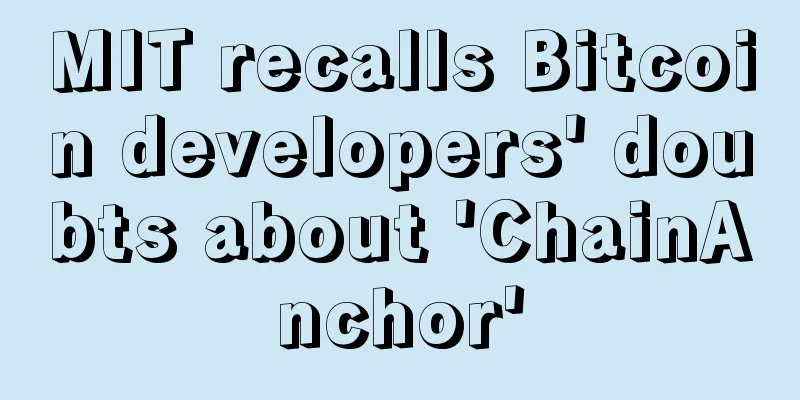MIT recalls Bitcoin developers' doubts about 'ChainAnchor'

Translation: Nicole A blockchain project developed at the Massachusetts Institute of Technology (MIT) has received new attention this week after criticism of alleged design elements, although those involved have denied the authenticity of the claims. It was all sparked by the events of April 21, when Bitcoin Core developer and blockchain consultant Peter Todd published what he believed to be a “leaked copy” of a document related to an MIT connection science research project called ChainAnchor. In the article, Todd, a threat analyst who works with both Bitcoin and non-Bitcoin companies, decried a project that seeks to “bribe” these Bitcoin miners by rewarding these unauthenticated participants for not conducting transactions. Peter Todd Todd told CoinDesk:
The speech drew criticism from MIT’s Bitcoin social media channel, which even tried to encourage miners to pledge that they would not support such a plan. MIT responded to the criticism in a statement to CoinDesk today, denouncing the article as having no substance. An MIT spokesperson said:
The university updated a white paper on April 17, which is linked to the ChainAnchor project. In contrast, Todd’s slides and image tags were dated February, and although they are similar to MIT’s, they have made significant changes. For example, the ChainAnchor document states that the project is intended to “address identity and access control issues in shared permissioned ledgers.” Moreover, the language of the filing suggests that the system (while inspired by Bitcoin) is not intended to run on the live Bitcoin blockchain. Todd's critical articles The release of the white paper appears to challenge critical articles by Todd, who said the system looks a lot like the one he presented, and mining companies using his published slides on public blockchains. He told CoinDesk:
He went on to say that even if the system is used on a private network, it is important to consider how dangerous such an architecture would be on a public blockchain like Bitcoin. Acknowledging that his statement might be irrelevant if the project was intended to be offered on a permissioned network, he said:
He added:
Overall, Todd’s comments express a concern that Bitcoin’s use case as a store of value has fallen out of favor with industry startups, and he worries that other better solutions will keep users using the network. Such comments come amid a long-standing debate over how bitcoin can be used on a large scale, though one that could be answered in the upcoming release of Segregated Witness, a possible solution. As for MIT, it reiterated its support for the Bitcoin network in its current form, but said that ChainAnchor is more closely associated with larger consortiums such as R3, where permissioned blockchain systems require new ways of establishing trust. MIT says:
The spokesperson said such a system could make permissioned blockchains more compliant with anti-money laundering (AML) and know-your-customer (KYC) regulations. MIT said it will work to bring the blockchain system into closer compliance with the rules of a white paper due in May. |
<<: Top gaming platform Steam to accept Bitcoin payments
>>: Why regulators are trying to broker blockchain integration for Irish banks
Recommend
Are people with full foreheads necessarily talented? Analyze the fate of people with full foreheads
Are people with full foreheads very capable? Peop...
Hair reflects your fortune. Look at your hair to see your recent fortune changes
Hair becomes smooth If you find that your hair ha...
Physiognomy Comments on the Cause and Effect of Fei Feng's Love
Physiognomy Comments on the Cause and Effect of F...
What does a mole on the palm mean?
What does a mole on the palm mean? What are the s...
The headquarters of the competing currency trading platform Cryptsy is deserted, which may be related to the difficulty of withdrawing funds
Bitcoinist has received exclusive news about altc...
How is the relationship between parents and children of the mole that kills children?
If a person has a mole that kills children, then ...
How to tell a woman's bad fate from her face
In fact, many women have bad fates due to some ex...
What kind of career line is considered "long and biased"
What kind of career line is considered "long...
The face of a woman who is not easy to marry
The face of a woman who is not easy to marry Most...
Anhui's first Bitcoin theft case has been transferred to the court, and the suspect may be subject to criminal liability
According to Phoenix.com, the "June 20" ...
To protect people's "purses", the central bank continues to increase supervision of virtual currencies such as Bitcoin
People's Daily Online, Beijing, August 31st. ...
We all forget that Bitcoin does not yet have a globally accepted story
Everyone has a different understanding of volatil...
Iran Plans to Ban Crypto Payments Except National Crypto
According to BlockBeats, on July 2, the Iranian p...
Detailed explanation of Vitalik Buterin’s new proposal: Why can EIP-3298 reduce gas fees?
According to GitHub, Vitalik has updated the EIP-...
Tellor TRB GPU Mining Tutorial
Tellor Binance invested in DeFi-specific oracle O...









